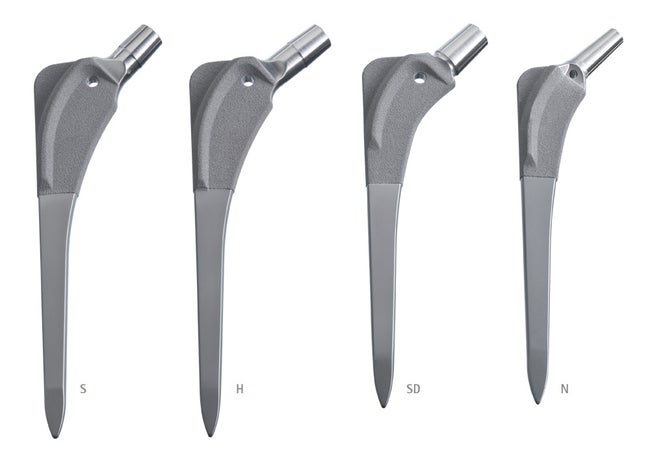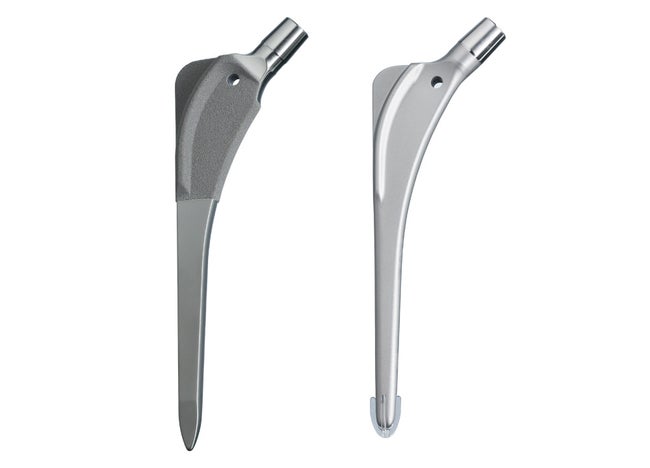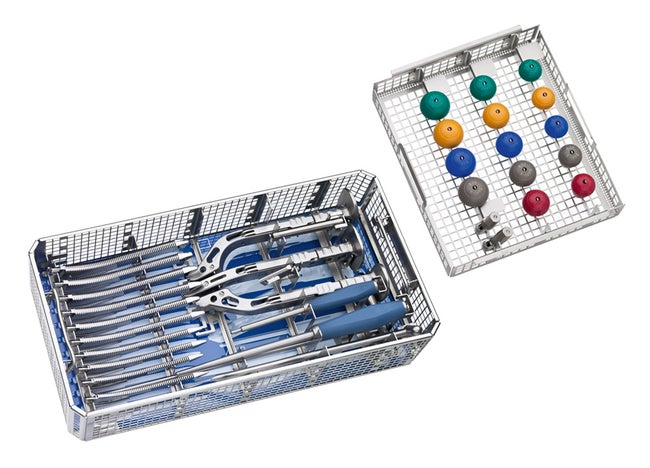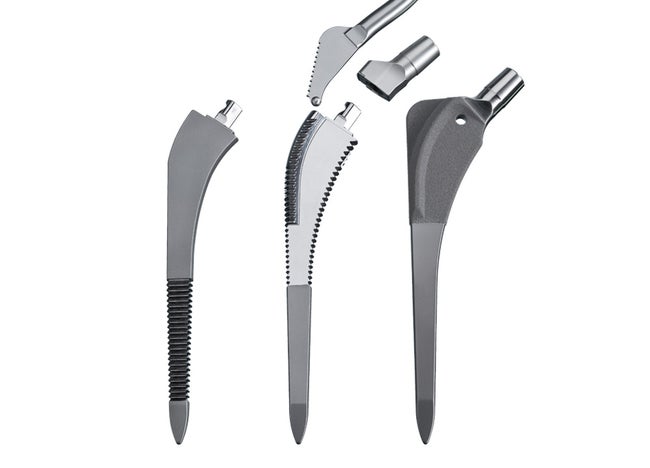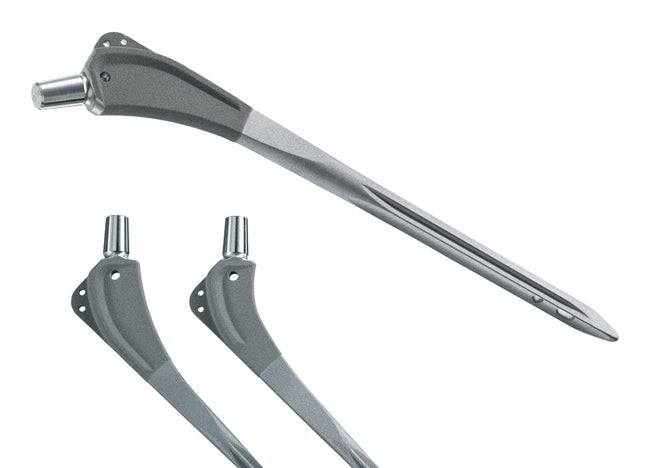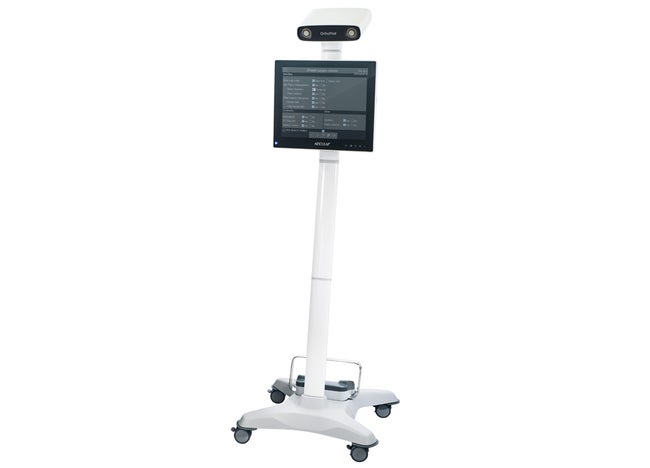Bicontact® Hip Stem System
Bone preservation. For years to come.
The Bicontact® philosophy is maximum preservation and protection of the existing bone substance. Based on the simple but crucial fact that the success of the prosthesis fixation depends on both – implant and bone. To do this, instruments were developed that compress the bone instead of removing it. The Bicontact® system comprises various stem types – for different anatomic morphologies.
The Bicontact® Hip Endoprosthesis System:
The bone preserving operation technique for cementless or cemented implantation. For primary and revision surgery.
Learn more about
Design
Different bone shapes. Various design solutions.
The Bicontact® implant range comprises stem types for different bone morphologies. Normal, dysplastic and very tight conditions in the marrow cavity.
For normal medullary canal conditions, the Bicontact® stem design offers the standard stem type S or type H (high offset). For smaller bone conditions the Bicontact® SD stems are the suitable choice. For exceptional cases such as extremely severe dysplastic changes with very narrow conditions in the femoral canal, the range of Bicontact® N stems can be chosen.
The design solutions differ mainly in the upper medial section, which is responsible for anchoring the prosthesis. For all stem types, the distal stem is tapered into a flat, tapered end.
Intraoperative Decision-Making
Bicontact® stems for cementless or cemented implantation: Coming to the right decision during the operation.
The situation found during the surgery enables or determines the right choice of procedure. The surgeon is free to make a decision, not only before, but also during the operation.
With Bicontact® the possibility exists to decide intraoperatively whether to perform a cementless implantation or to implant with bone cement. The Bicontact® stem can be anchored in the bone either by making use of the Plasmapore® surface or by applying the most recent cementing techniques.
Modern Platform Instruments
The modern Bicontact® implantation instrument combines many years of experience, proven methods and the support of correct intraoperative decisions for a reliable treatment of the hip joint.
One and the same procedure for all Bicontact® stem types – cementless or cemented.
The Bicontact® can be implanted with the Osteoprofilers in a minimally invasive procedure. As a muscle sparing measure, the trochanteric wing is only prepared in a last step.
The user can choose between two rasp versions: the A & B Osteoprofiler or the compact profiler that combines the A&B Osteoprofiler in one single rasp.
Design Revision Stem
The revision of a hip prosthesis requires a particularly careful procedure. The revision should preserve as much substance as possible and support the reconstruction of the bone. For a revision the implant requires bone substance, for stable fixation. Therefore, the principle of Bicontact® revision is: bridging the defect zones. With secure locking with screws, if necessary. And, of course, with the proximal Bicontact® design with different stem lengths, straight, curved or SD type for narrow bone conditions.
OrthoPilot® Navigation
Computer-assisted planning and operation procedures help the surgeon in modern hip replacement. Intelligent instruments support his manual skills. In this way, experience and operating techniques are developed further. Implanting a hip prosthesis requires manual skill and making the right intraoperative decisions. By using OrthoPilot® navigation system, the surgeon gains implantation data, which he can compare to his operative procedure, in all surgeries especially the ones where he encounters some difficulties.
Literature
Clinical Outcome – Cementless
Ateschrang A, Weise K, Weller S, Stöckle U, de Zwart P, Ochs BG
Long-term results using the straight tapered femoral cementless hip stem in total hip arthroplasty: a minimum of twenty-year follow-up. J Arthroplasty. 2014 Aug;29(8):1559-65.
Weller S, Rupf G, Ungethüm M, Stallforth H
Das Bicontact Huftendoprothesensystem – ein zementfrei oder zementiert implantierbares, femurschaftadaptiertes Huftendoprothesensystem. Medizinisch-Orthopadische Technik. 1988;6:222-7.
Volkmann R
Das Bicontact Endoprothesensystem – mittelfristige Ergebnisse nach 5jahriger Anwendung. Aktuelle Traumatol. 1993 Jul;23 Suppl 1:75-81.
Eingartner C, Volkmann R, Pütz M, Weller S
Niedrige Lockerungsrate einer zementierten Titan-Gradschaftprothese im langerfristigen Verlauf. Swiss Surg. 1997;3:49-54.
Asmuth T, Bachmann J, Eingartner C, Feldmann C, aus der Fünten K, Holz F, et al.
Results with the cementless Bicontact stem – multicenter study of 553 cases. In: Weller S, Volkmann R, editors. The Bicontact hip system. Stuttgart: Thieme Verlag. 1998. p. 63-74.
Takata ET, Basile R, Albertoni WM
Experiences with Bicontact ceramic-ceramic total hip arthroplasty. Z Orthop Unfall. 2007 Sep-Oct;145 Suppl 1:25-8.
Tsukada S, Wakui M
A Case Series of Total Hip Arthroplasty Using Cementless Hip Stem Customized for Patients of a Specific Race: 10- to 15-Year Results. J Arthroplasty. 2016 Jan;31(1):190-3.
Volkmann R, Eingartner C, Winter E, Weise K, Weller S
Midterm results in 500 titanium alloy femoral stam prostheses – cemented and cementless technique. Eur J Orthop Surg Traumatol. 1998;8:133-9.
Kohler S, Nahmmacher V
12-year results with the cementless Bicontact SD stem in dysplastic and narrow femoral bone conditions. Z Orthop Unfall. 2007 Sep-Oct;145 Suppl 1:13-9.
Alexander Grimberg, Volkmar Jansson (Wissenschaftlicher Direktor), Jörg Lützner, Oliver Melsheimer, Michael Morlock, Arnd Steinbrück
Endoprothesenregister Deutschland (EPRD). Annual Report 2019. Berlin, 2019
Weller S, Braun A, Gekeler J, Volkmann R, Weise K
Das Bicontact Huftendoprothesen System. Stuttgart: Thieme Verlag. 1998.
Eingartner C, Volkmann R, Winter E, Maurer F, Sauer G, Weller S, et al.
Results of an uncemented straight femoral shaft prosthesis after 9 years of follow-up. J Arthroplasty. 2000 Jun;15(4):440-7
Drobniewski M, Borowski A, Synder M, Sibiñski M
Cementless Total Hip Arthroplasty with BiCONTACT Stem – Good Results at Long Term of Follow–up. Ortop Traumatol Rehabil. 2014;1(6);Vol16:91-4.
Swamy G, Pace A, Quah C, Howard P
The Bicontact cementless primary total hip arthroplasty: longterm results. Int Orthop. 2012 May;36(5):915-20.
Eingartner C, Maurer F, Sauer G, Winter E, Weise K, Weller S
Langzeitergebnisse mit dem Bicontact-Schaft. Aktuelle Traumatol. 2001 Aug;31:149-55.
Agarwala S, Jhunjhunwala, Pachore JA, Joglekar SB, Eachempati KK
Results of uncemented distal locked prosthesis in revision hip arthroplasty with proximal femoral bone loss: A retrospective study. Indian J Orthop. 2013 Jan-Feb;47(1):83-6.
Flamme CH, Wirth CJ, Stukenborg-Colsman C
Charakteristik der Lernkurve bei der Hufttotalendoprothese am Beispiel der Bicontact-Prothese. Z Orthop Ihre Grenzgeb. 2001 May-Jun;139(3):189-93.
Badhe NP, Quinnell RC, Howard PW
The uncemented Bicontact total hip arthroplasty. J Arthroplasty. 2002 Oct;17(7):896-901.
Eingartner C, Heigele T, Dieter J, Winter E, Weise K
Long-term results with the Bicontact system – aspects to investigate and to learn from. Int Orthop. 2003;27 Suppl 1:11-5.
Lerch M, Kurtz A, Windhagen H, Bouguecha A, Behrens BA, Wefstaedt P, Stukenborg-Colsman CM
The cementless Bicontact stem in a prospective dual-energy X-ray absorptiometry study. Int Orthop. 2012 Nov;36(11):2211-7.
Thorey F, Lerch M, Kiel H, von Lewinski G, Stukenborg-Colsman C, Windhagen H
Revision total hip arthroplasty with an uncemented primary stem in 79 patients. Arch Orthop Trauma Surg. 2008 Jul;128(7):673-8.
Clinical Outcome – Cemented
Eingartner C, Piel K, Weise K
Results of a cemented straight titanium alloy femoral stem after mean follow-up of 13 years. Eur J Orthop Surg Traumatol. 2007;17:587-93.
OrthoPilot® Navigation
Kiefer H, Othman A
The Orthopilot navigation system for primary Bicontact total hip replacement. Z Orthop Unfall. 2007 Sep-Oct;145 Suppl 1:49-52.
Braun A, Acker M
Bicontact Plasmacup THA in patients with staged bilateral hip replacement. Z Orthop Unfall. 2007 Sep-Oct;145 Suppl 1:9-12.
Material & Design
Fink U
Plasmapore: a plasma-sprayed microporous titanium coating to improve the long term stability. In: Mainard D, editor. Acutalites en Biomateriaux Vol. III. Paris: Romillat Edit. 1996. p. 97-104.
Weller S, Braun A, Gellrich JC, Gross U
Importance of prosthesis design and surface structure for primary and secondary stability of uncemented hip joint prostheses. In: Learmonth ID, editor. Interfaces in total hip arthroplasty. London: Springer Verlag. 1999. p. 81-101.
Eingartner C, Ilchmann T, Dieter J, Weise K
Subsidence pattern of a cementless straight titanium alloy femoral stem – a radiographic study with EBRA-FCA. Hip Int. 2005;15(2):85-91.
Yoo JJ, Kim YM, Yoon KS, Koo KH, Song WS, Kim HJ
Alumina-on-alumina total hip arthroplasty. A five-year minimum follow-up study. J Bone Joint Surg Am. 2005 Mar; 87(3):530-5. 29
Ochs U, Eingartner C, Volkmann R, Ochs BG, Huber C, Weller S, et al.
Prospective long-term follow-up of the cementless Bicontact hip stem with plasmapore coating. Z Orthop Unfall. 2007 Sep-Oct;145 Suppl 1:3-8.
Braun A, Papp J, Reiter A
The periprosthetic bone remodelling process – signs of vital bone reaction. Int Orthop. 2003;27 Suppl 1:7-10.
Lee YK, Ha YC, Yoo JJ, Koo KH, Yoon KS, Kim HJ
Alumina-on-alumina total hip arthroplasty: a concise followup, at a minimum of ten years, of a previous report. J Bone Joint Surg Am. 2010 Jul 21;92(8):1715-9.
Reiter A, Gellrich JC, Bachmann J, Braun A
Verlauf der periprothetischen Mineralisationsdichte nach Implantation des zementfreien Bicontact-Schaftes; Einfluss verschiedener Parameter – ein prospektives Follow-up uber 4 Jahre. Z Orthop Ihre Grenzgeb. 2003 May-Jun;141(3):283-8.
Ki SC, Kim BH, Ryu JH, Yoon DH, Chung YY
Squeaking sound in total hip arthroplasty using ceramic-onceramic bearing surfaces. J Orthop Sci. 2011 Jan;16(1):21-5.
Bicontact® Revision
Eingartner C, Volkmann R, Winter E, Weise K, Weller S
A long straight stem with distal interlocking for uncemented stem revision in THR. In: Szabo Z, editor. Surgical Technology International IX. San Francisco: Universal Medical Press Inc. 2001. p. 273-9.
Ochs BG, Volkmann R, Eingartner C, Ludolph I, Weller S, Weise K, et al.
Treatment of large femoral bone defects – 15-year experiences with the cementless Bicontact revision stem with distal interlocking. Z Orthop Unfall. 2007 Sep-Oct;145 Suppl 1:34-9.
Eingartner C, Volkmann R, Pütz M, Weller S
Uncemented revision stem for biological osteosynthesis in periprosthetic femoral fractures. Int Orthop. 1997;21(1):25-9.
Volkmann R, Bretschneider C, Eingartner C, Weller S
Revision arthroplasty – femoral aspect: the concept to solve high grade defects. Int Orthop. 2003;27 Suppl 1:24-8.
Kim YM, Kim HJ, Song WS, Yoo JJ
Experiences with the Bicontact revision stems with distal interlocking. J Arthroplasty. 2004 Jan;19(1):27-34
Eingartner C, Volkmann R, Ochs U, Egetemeyr D, Weise K
Intramedullary stabilization of periprosthetic fractures of the femur taking special account of bone defects. Oper Orthop Traumatol. 2006 Oct;18(4):341-63.
Thorey F, Lerch M, Kiel H, von Lewinski G, Stukenborg-Colsman C, Windhagen H
The uncemented primary Bicontact stem in revision total hip arthroplasty in young patients. Z Orthop Unfall. 2007 Sep-Oct; 145 Suppl 1:40-3.
Volkmann R, Bretschneider K, Erlekampf E, Weller S
Revision surgery in high grade acetabular defects with thermodisinfected allografts. Z Orthop Unfall. 2007 Sep-Oct;145 Suppl 1: 44-8.
Eingartner C, Ochs U, Egetemeyer D, Volkmann R
Treatment of periprosthetic femoral fractures with the Bicontact revision stem. Z Orthop Unfall. 2007 Sep-Oct;145 Suppl 1:29-33.
Videos
-
Bicontact® Hip Endoprosthesis System
Video
